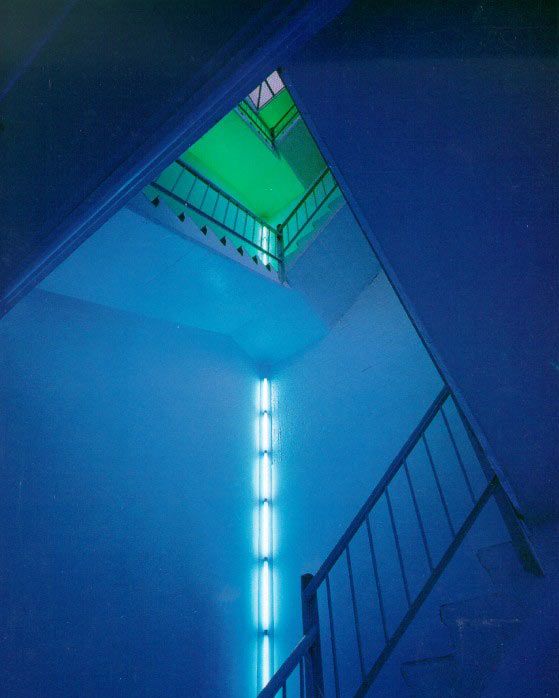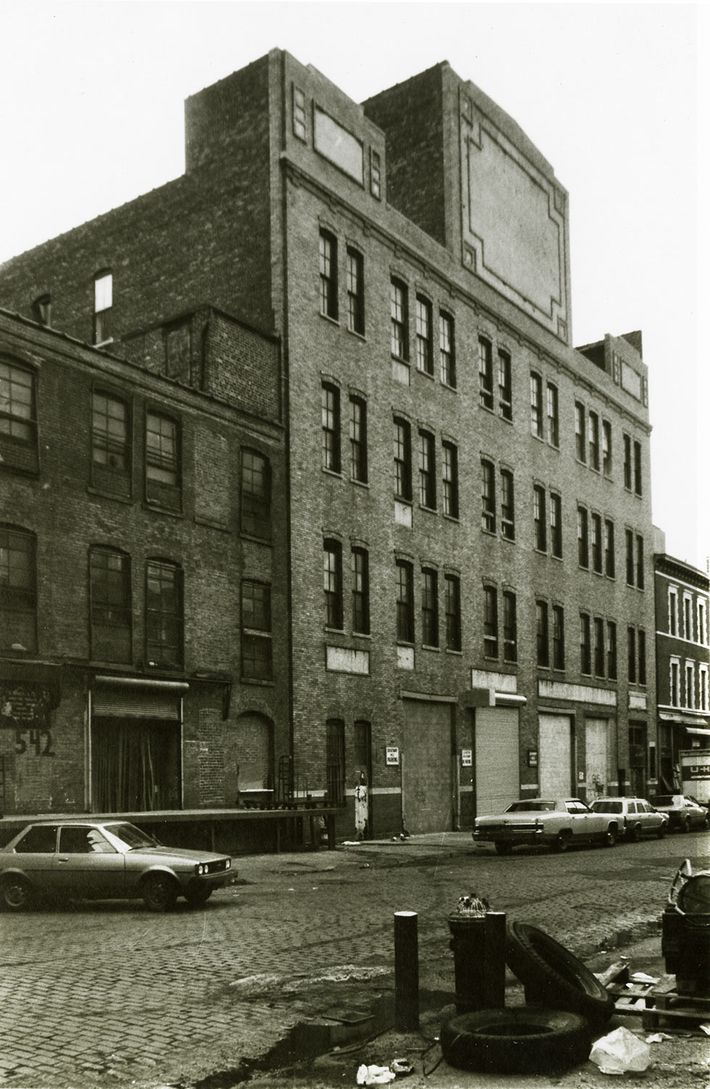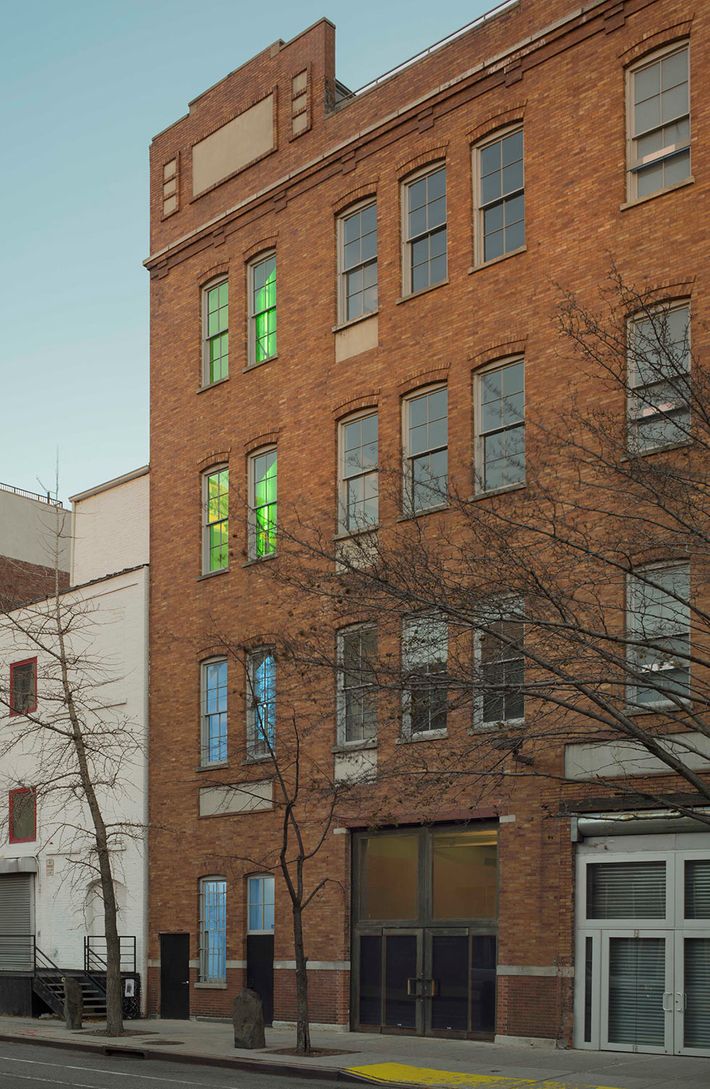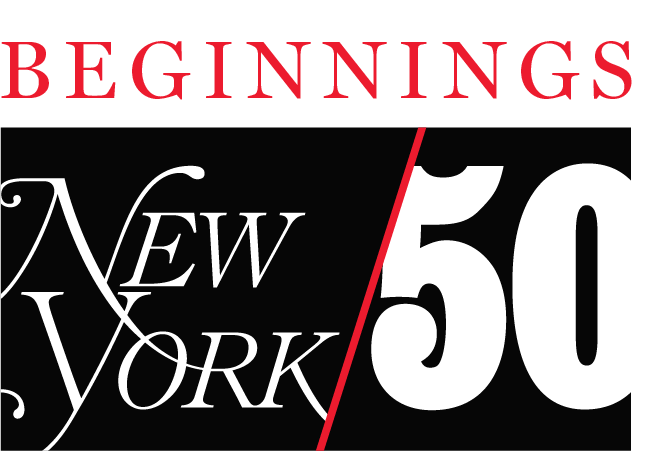
In celebration of New York Magazine’s 50th anniversary, this series, which will continue through October 2018, tells the stories behind key moments that shaped the city’s culture.
On a long list of exotic locales associated with the Dia Art Foundation — the dusty desert in New Mexico, rocky shoreline around Utah’s Great Salt Lake, the alien wilds of Marfa, Texas — is a remote destination a little closer to home: West 22nd Street between 10th and 11th Avenues. Though it now rates as prime real estate in one of the most development-mad districts of Manhattan, the idyllic Chelsea block was less desirable in 1987, when Dia set up shop with the quixotic aim of luring gallerygoers there from Soho. The neighborhood, inasmuch as it could then be deemed as such, consisted of working industry (automotive repair, marble cutters, warehouse space) and sidewalks that were empty at night. Across from Dia, there was a makeshift bar that sometimes spun off barbecues and stickball games in the street. On blocks nearby, there were gunfire blasts and gatherings in seedy S&M haunts and a general sense of dereliction that explains an art review with the headline: “Lugubrious Jenny Holzer Exhibit at One of the City’s Creepiest Spots.” Chelsea then was not like Chelsea now, with hundreds of gleaming galleries and luxury penthouses fetching more than $50 million — but, thanks in part to Dia’s prescient move, it would soon be on its way.
Dia currently occupies three different addresses along West 22nd Street. But a formidable building at 548 West 22nd Street — home to the Dia Center for the Arts from 1987 to 2004, before being offloaded more than a decade ago — was the heart of the foundation for a transitional era during which the surroundings could not have changed more dramatically. “It was a dicey outpost at the time,” said Charles Wright, Dia’s director in the mid-’80s and the mastermind of its rise in Chelsea. “People said, ‘Don’t do this.’ People who had been in Manhattan real estate for 20 or 30 years said, ‘This is not going to happen.’ A lot of gallerists in Soho said, ‘That’s nutty — nobody will go.’”
The building, home now to a temporary incarnation of the gallery Hauser & Wirth and slated for new development in the future, had been purchased in 1981, before Wright’s tenure, as part of a years-long buying spree that landed Dia properties all around Manhattan and beyond. The four-story site on 22nd Street looked prime for storage and maybe space to show art. “Part of our brief had been looking for fireproof buildings, and the purpose of that was to find a building that would be safe for Barnett Newman’s work,” recalled the architect Richard Gluckman, who worked with Dia from its beginning in 1974. Though an exhibition space for Newman never materialized, fireproof buildings would come to be one of Chelsea’s calling cards. “Unlike Soho, which was built in the 19th century with brick and wood frames,” Gluckman said, “Chelsea was built at the beginning of the 20th century, when they just started using reinforced concrete in warehouse and factory-type structures.”
For six years before opening to the public, 548 West 22nd Street was used to store Dia’s collection. The rest of the block was sparsely populated by enterprises including a carport, a shipping depot, and the Santini Brothers moving company. The few people who made their way there were itinerant. “There were a lot of homeless people living on the street, especially under the High Line,” Dia’s longtime director of operations Jim Schaeufele said. Otherwise, “it was pretty dead.”
Over at 515 West 18th Street was the legendary roller-disco club the Roxy, and there were at least occasional stirrings of different kinds of action nearby. William Stone, an artist who bought up buildings on 10th Avenue in 1979, owned a space that had previously functioned as a leather bar called the Strap. “There were whips and chains hanging from the ceiling,” Stone said. “There was even a tub in the back for golden showers.” In 1980, Stone helped stage an exhibition there of work by his friends under the title “The Bad Light Photography Show.” The group affair warranted a review in Art in America by a young Jeffrey Deitch, who wrote, “The dozens of belts, whips and chains left hanging from the ceiling by the former tenants set an appropriate tone for the art tacked and taped to the walls. Almost all of the participants seem to share a sense of civilization sliding into degeneracy, some seemingly haunted by the deterioration, others eerily celebrating it.” Deitch found a lot to like in the “deliberately un-slick” show and the ways it doubled as “a gesture demonstrating that art doesn’t require boards of directors, patrons’ committees and curators to reach the public.”
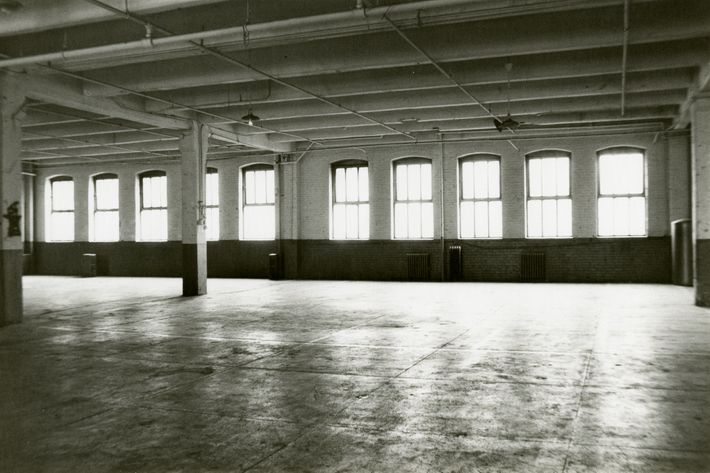
The decision to try to summon the public to Chelsea came at a tumultuous time for Dia, which had been founded as an enterprise devoted to monumental art with a solemn sense of purpose. Vast sums of money were invested in a small stable of mostly minimalist artists, whose work would be supported by a form of patronage that peered back to the Renaissance for a model. (A seven-page article about Dia in New York in 1985 bore the headline “Medicis for a Moment,” in reference to the wealthy Italian family who helped make 15th-century Florence bloom.)
But the source of that money — an oil fortune with a lineage in European high society and the new postwar American metropolis of Houston, Texas — proved volatile, and when a supply glut sent oil prices tumbling in the early ’80s, the foundation found itself overextended and deeply in debt. (That same New York article reported that more than $30 million was spent on artists who were given monthly stipends and sometimes entire buildings for their work.)
When the financial burdens proved too much to bear, Dominique de Menil — the storied art patron and mother of Philippa de Menil, who founded Dia with the German art dealer Heiner Friedrich and Houston transplant Helen Winkler — lent support to help stabilize the foundation. Artworks from the collection (by Cy Twombly, Andy Warhol, Donald Judd, and others) were auctioned off and numerous real-estate holdings were sold, including a large six-story Tribeca edifice that played home to La Monte Young and Marian Zazeela’s whirring drone-music installation Dream House, and a building on West 19th Street that served as a base for the performance artist Robert Whitman (a site now occupied by the performance venue the Kitchen). Some of the original Dia properties remained, including two gallery spaces in Soho that are still inhabited by permanent artworks by Walter De Maria (The New York Earth Room and The Broken Kilometer) — and the big building on 22nd Street.
When Wright took on Dia’s directorship in 1986, he surveyed what remained in the foundation’s holdings. “When I interviewed for the job, I think they assumed that someone was going to come in and just help liquidate and convert certain assets to cash and that it would be a grant-making program at the end of the day,” Wright said of a board of directors that had been installed to address the financial woes. “As I looked around to see what was there, I began to generate ideas for a possible program, which had not been contemplated at that point.”
When he moved to the city from Seattle, Wright and his family took an apartment on 23rd Street between 10th and 11th Avenues. “You could walk comfortably down those streets in the middle of the day and not be interrupted by traffic,” he remembered. “You might be interrupted by drug deals or other things taking place.”
One formidable gallery outpost existed — the first, in fact, in the neighborhood: a small shop opened by Larry Gagosian in 1985, on West 23rd Street near where the Half King pub is today. Though Gagosian would return years later as a major force in Chelsea’s gallery district, with two large spaces now on West 24th and 21st Streets, his first foray did not last long, characterized as a “mistiming error” in the 2014 book New York’s New Edge: Contemporary Art, the High Line, and Urban Megaprojects on the Far West Side.
Wright, however, considered a building that loomed impressively in an area beyond the art world’s familiar boundaries to be in keeping with Dia’s tradition. “Dia was not so much on the radar at that point,” said Gary Garrels, who worked as Dia’s director of programs from 1987 to 1991 (and serves as a curator at the San Francisco Museum of Modern Art today). “It was not very widely known, and that was a legacy of Heiner and Philippa, who felt that interested people would find it. It wasn’t advertised — you had to become aware of it by your involvement in contemporary art.” That foundational habit of withholding and restraint, Garrels said, had made Dia sites “places of pilgrimage.”
“Dia spaces were and are shrines to art,” said Jenny Holzer, who mounted a show at the Dia Center in 1989. She remembered early impressions of permanent installations such as The New York Earth Room and The Lightning Field in New Mexico (also by Walter De Maria) striking her as “like Stonehenge, only fresh.”
With such a legacy in mind, Wright worked to make previously secretive projects more public in nature. He convened a group of curators and artists — Kasper König, Harald Szeemann, Kathy Halbreich, Yvonne Rainer, Richard Bellamy — to discuss an approach to programming that would be “continuous with the ethos of Dia but allow for ongoing visibility.” Wright also helped conceive “Discussions in Contemporary Culture,” a talk series presented with the noted art historian Hal Foster. “At that time, critical theory was alive and thriving and under-recognized by institutions,” Wright recalled. “I thought, Well, that’s easy — we could take that and stand out.”
Most prominently, Wright turned his attention to transforming the building on 22nd Street. Chelsea was raw and forbidding, Wright recalled, but “it seemed like if we had that much space — almost 40,000 square feet — devoted to good programming, there would be enough gravity that it could draw.”
Gluckman, the architect, had already devised a signature aesthetic known well among those who knew Dia at all. “What I’d learned from working with Heiner years earlier was not to embellish a building, to keep it stripped down,” Gluckman said. “It was more of a reductive attitude than minimalist. The art was going to interact with the structure of the building, so we wanted to make a careful intervention to minimize any superfluous detailing.”
The building itself was significant for the ways it gibed with a favorite book of Gluckman’s by Reyner Banham, A Concrete Atlantis: U.S. Industrial Building and European Modern Architecture. Published in 1986, it proposed links between aspects of early-20th-century American factory-building and the rise of Modernism as imagined by European architects, who borrowed design priorities such as the enlistment of natural light by way of skylights and large windows. The 22nd Street building had those as well as “a generosity of space and scale” that was typical of industrial buildings of its kind, Gluckman said. “It was much more appropriate for the kind of large-scale work that was being done by the Abstract Expressionists and artists of the ’60s and ’70s.”
He kept his interventions to a minimum. “My biggest achievement on that building was convincing the fire chief to let me take the sprinklers out of the main spaces,” Gluckman said. “I don’t think they would let you do that today, even in a concrete building.” The stairs were too steep for current city building codes, as anyone who has marched up them even now can attest, but those were grandfathered in. Otherwise, Gluckman conceived an unusual system of fixed-point halogen lighting that provided an amorphous all-over wash of illumination (“the kind of art being made then did not demand spotlights — it wanted walls that were lit evenly from top to bottom and side to side”) and a way to make a virtue of spare concrete flooring (“we put a cementitious paint on the floor that softened the light. It was a product that was developed in Switzerland to repair concrete bridge work, and it had a matte finish that we loved”). The overall look and feel — an unadorned industrial space with austere white walls and a gray cement floor — was new for the time but has become standard in galleries today.
“The renovation of 22nd Street was exactly what artists needed,” Holzer said. “Richard’s touch was light, deft, and dignified” in ways that “stand in contrast to boastful architecture that competes with art or even takes it down.”
Schaeufele, the operations director, put it more tersely: “It was a typical Dia job — do a minimal amount of work and let the building speak for itself.”

Then came the art. When the Dia Center opened to the public in October 1987, the program began with three exhibitions that would be open for eight months, in keeping with the long- and sometimes even permanent-duration habit that Dia had always followed. On three floors, each devoted solely to one artist, were works by Joseph Beuys, Imi Knoebel, and Blinky Palermo. The Beuys work included imposing stacks of thick felt sheets arranged in tall sculptural forms that “absorbed the surrounding sound waves, resulting in a dull pulsating silence,” as a Dia show description stated. The Knoebel floor was given over to lacquered paintings and geometric arrangements of panels and boards. And then there was To the People of New York City, an enigmatic array of minimalist paintings by Blinky Palermo, the German artist who took the name of an American con man during a brief career before he died at age 33.
Little is known for certain about the piece, which was discovered in Palermo’s studio in 1977 and which Dia will show again this fall for the first time in 30 years in Chelsea. The work’s tricolor palette of yellow, red, and black might allude to the German flag, Native American symbology, or Piet Mondrian (Roberta Smith of the Times overheard someone call it “a sequential Broadway Boogie Woogie”), and the ordering system for the panels was not fully described. Anne Rorimer, a scholar and curator writing in a Dia publication later, noted how the work “absorbs and is absorbed by its surrounding exhibition space.”
The three shows were well-received by some, but “in the beginning there could be weeks when you would only see 15 people,” Schaeufele remembered — “it was a slow start.” As Garrels recalled, “Sometimes on the weekend there wasn’t a soul for blocks.”
Wright, for his part, was “begging gallerists to consider space [in Chelsea],” he said. “Soho at that point was getting pricy, and you could get much more space up where we were. I talked to every gallerist I knew. It was a difficult argument to make, but there was hope.”

It would be a while still. “I remember there was a murder in the park after we had been living there for a couple years,” said Paula Cooper, the noted Soho gallerist who kept her space downtown when she moved into an apartment in Chelsea in 1987. “This was the park on 22nd Street, where children now leave their toys trustfully overnight. I never felt it was really dangerous, but it was a very unsavory neighborhood.”
Hilton Kramer certainly thought so. In a New York Observer review of Holzer’s 1989 show at the Dia Center that ran with that “Creepiest Spots” headline, the famously conservative art critic expressed dismay for having been dragged into what he characterized as a kind of brimming urban hellscape. “Before attempting to describe what there is to be seen in this exhibition,” Kramer wrote, “I should warn readers of The Observer that they must not expect it to be a lot of fun to venture into the western reaches of 22nd Street in search of aesthetic enlightenment — unless, of course, they happen to have a passion for trailer trucks, loading docks and the kind of unwelcoming streets in which potholes are likely to outnumber people even on a bright spring day.”
The allure for certain explorers was not lost on him entirely. “In the interests of art we must all forego certain pleasures from time to time, and the dramaturgical necessity for locating this outpost of cultural chic in such a dismal setting is entirely understandable,” Kramer conceded. “It guarantees that what we find when we get there will look — well, a little more interesting than it might look if it were located in some more agreeable emporium uptown or in SoHo.” (Alas, the Holzer show, which consisted of 13 large stone sarcophagi with carved text, did not quite do it for him.)
No doubt Kramer would have been disconcerted by a memory of William Stone’s from some time in the ’80s, when people would sneak up on the abandoned West Side Line (now known as the High Line) — “the stairs were intact; they weren’t blocked off” — to avail themselves of drugs and other illicit activities that would carry down to the ground level. “There were all these trucks stored across the street, and one day the coroner was there,” Stone said. “There was something about it that was kind of odd.” As he learned from a fellow onlooker, “some guy was in the back of a truck doing that thing where you choke yourself — when you lean forward and partially strangle yourself, like taking a popper — and he died.” The fateful result of autoerotic asphyxiation, Stone said, “is a vision that stuck in my mind.”
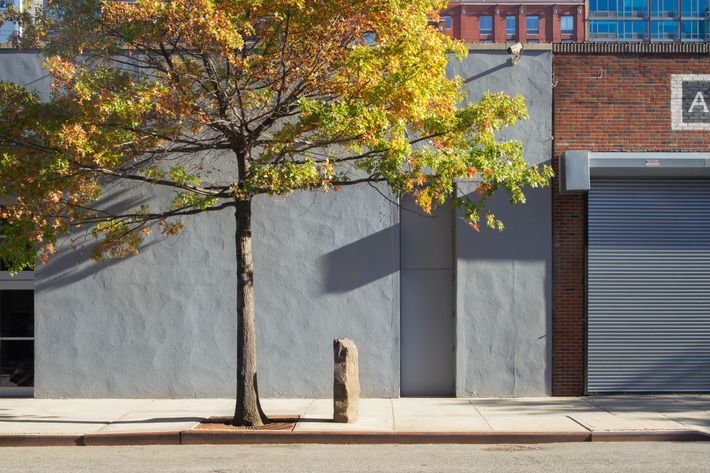
A Dia-commissioned artwork from around that time with a more life-affirming spirit is still a hallmark of Chelsea for those aware of its presence: a Joseph Beuys–conceived series of trees planted next to accompanying basalt columns along the sidewalk, each in a sort of conjoined pair. The project, titled 7000 Oaks and first taken up in New York in 1988, had originated at the quinquennial Documenta exhibition in Kassel, Germany, where some Dia travelers had seen it. “We thought, Why don’t we bring it to Chelsea and improve the neighborhood?” Wright remembered.
“Soho at that point had already become a shopping mall,” Garrels remembered. “This was like the old-school New York art world — there was a recovery of some of that spirit. I had a good sense of uptown and downtown, and I wanted the two worlds to mix. Chelsea could be a meeting place and bring different cohorts of the art world together.”
As noted in a Dia press release for 7000 Oaks from the time, Beuys, who died two years earlier, had previously stated a liking for the matched pairings of a “a living part” (the trees) and a “crystalline mass” (the columns) that would change in relation to one another over time. The inevitable shift would mark “a symbolic beginning,” he wrote. “And such a symbolic beginning requires a marker. The intention of such a tree-planting event is to point up the transformation of all of life, of society, and of the whole ecological system.”
In front of 548 West 22nd Street, five trees were planted — not just oak but also gingko, linden, Bradford pear, and sycamore. Beside them were five basalt columns sourced from a quarry near Kassel and shipped over to take up new positions in a new home. “They sent us more stones than we needed,” Garrels recalled. “They said, ‘New York is so tough you’ll probably need a couple extras.’”
Schaeufele said the precaution has served the project well, as a few of the stone columns — including 18 more planted next to additional trees in 1996 along 22nd Street as well as 10th and 11th Avenues — have been backed over by cars and knocked down as a result. “I actually still have some extras,” he said.
It would be another decade or so before there was any kind of mass Chelsea gallery migration. Issues with the neighborhood remained: Neil Selkirk, a photographer who bought a building on West 19th Street building as a live-work space in 1982 (and who happened to shoot pictures for the New York “Medicis for a Moment” story a few years later), recalled, “Around 1990, we moved for a while because there was semiautomatic-weapons fire. There was some rough stuff. I know the police found a tank made out of a van that had been armored and had a turret.”
Selkirk helped make homespun concrete barriers to protect trees from chaos on the streets, but the obstacles came to serve additional purposes. When nightclubs arrived in the neighborhood, he said, “People would drop their knives in the pits so they wouldn’t have to give them up in the metal detectors in the clubs. On Sunday mornings I would pick up knives. I took a big black garbage bag full of knives to a hearing at City Hall.”
But the vogue for new art from the present was revving up, such that Chelsea’s rise as a commercial gallery district in the mid-’90s coincided with the arrival of “contemporary art” as a dominant category in the art world. As chronicled in New York’s New Edge by David Halle and Elisabeth Tiso, the gallerist Matthew Marks was one of the first to move his operation to Chelsea, when, wanting more space than he had on the Upper East Side, his search for a space in Soho turned up nothing he could afford. In the book, Marks recalls getting a tip from Dia’s Charles Wright: “He said, ‘There’s this gorgeous garage in Chelsea near us that we’d have taken if we were looking for space, but we’re not.’” After six months of negotiating with an owner who didn’t quite understand what an art gallery was, he closed on a deal — after which point the lawyer said, “Congratulations! You own a garage on 22nd Street!”
After that, Marks helped entice Paul Morris and Pat Hearn up from Soho to buy and divide another garage between their two gallery operations, and then Paula Cooper opened a new shop on West 21st Street, with renovation work by Richard Gluckman. “Soho was not a pleasant area anymore,” Cooper said of leaving the neighborhood that her gallery had called home since 1968.
Others followed, including Barbara Gladstone, Metro Pictures, Andrea Rosen, Luhring Augustine — and, over time, the rest of the over 200 galleries that show art in Chelsea today. “It was like a brushfire,” said Garrels. He had left Dia a few years prior, and Wright stepped away from his directorship in 1994 — before the foundation turned toward a next phase upstate with the development of the palatial postindustrial museum Dia:Beacon in the Hudson River Valley after the arrival of Michael Govan (then a young upstart from the Guggenheim Museum and now, since leaving Dia in 2006, the director of the Los Angeles County Museum of Art).
In certain ways, Dia’s influence on the art march toward Chelsea dates back much farther than the ’70s and ’80s. Recalling his first arrival as a visitor to New York from postwar Germany, Heiner Friedrich, the Dia founder who just turned 80, remembered laying eyes on Manhattan’s West Side from a boat in 1955. “There was not one building for people to be,” Friedrich said of the inhospitable environs. “It was amazing — you would not believe.”
About Chelsea now, he sounded an upbeat note. “It’s a blessed and positive district in Manhattan because it allows people to be in touch with each other.” But future phases for the neighborhood remain to be seen. “One of the necessities for New York, being a city of rising strengths, is to manifest lasting settings for works of art that are accessible to the public,” Friedrich said. “This is one of the main issues in the city. All the commercialism is running to the sky.”
Even for Dia’s dreamers, such commercialism once seemed improbable. “What I hoped for did occur, but it didn’t occur while I was there,” Wright said of his inkling that people might visit a home for Dia decades back.
“I remember being told by dealers in Soho that no one would ever go to Chelsea,” Gluckman, the architect, recalled. “That wasn’t the case.”
Selkirk, still in the neighborhood after more than 30 years, said, “I was absolutely certain it had no future whatsoever. There were three or four galleries and then all of the sudden everybody was saying, ‘This is going to be it.’ It’s all a glorious blur.”
Andy Battaglia is the deputy editor of ARTnews magazine.
Photography by Michele Lanou. Courtesy Dia Art Foundation, New York.


